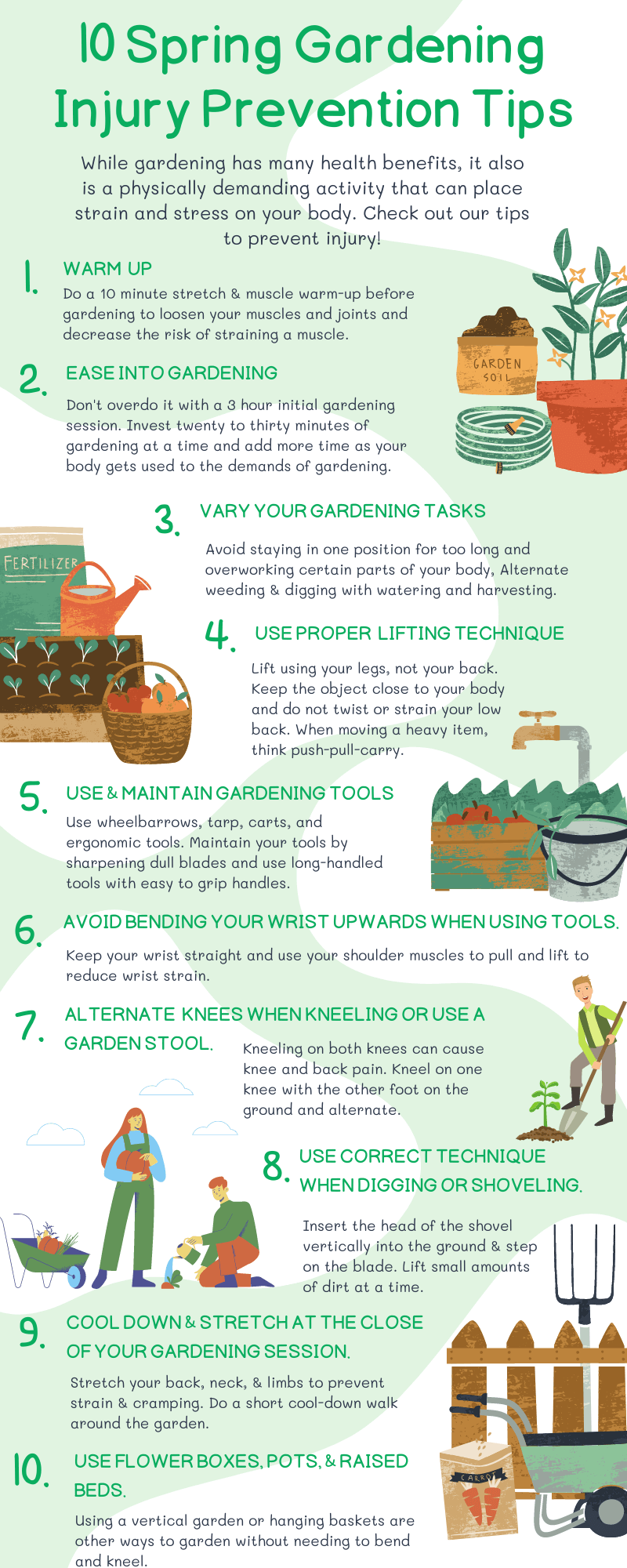Spring Gardening Injury Prevention Infographic
With the start of the warmer spring weather, many of us are getting out in our gardens, weeding, raking, and preparing for planting. Gardening has numerous health benefits: building strength, promoting sleep, boosting your mood, and getting some quality sunshine and Vitamin D. However, gardening does place stress and strain on joints and muscles when digging, planting, weeding, mulching, and raking. The knees, shoulders, back, and neck are particularly vulnerable to strain and injury when gardening.
Here are 10 tips to minimize strain and prevent injury when gardening this spring:
Always warm up with a ten-minute stretch and walk around your yard. This loosens your muscles and joints by increasing blood flow to the muscles and joints. This decreases the risk of straining a muscle.
Don’t overdo it with a three-hour initial gardening session. Pace yourself and ease into gardening with twenty-to-thirty-minute gardening sessions to allow your body to acclimate to the demands of gardening.
Alternate your gardening tasks. Staying in one position for too long and doing repetitive tasks can overwork and strain certain parts of the body, leading to low back pain or wrist tendinitis. Alternate 15 minutes of weeding and digging with 15 minutes of watering and harvesting.
Use proper lifting techniques. When gardening, you may lift heavy bags of mulch or carry various garden tools around the garden using a wheelbarrow. Lift using your legs, not your back, and keep the object close to your body. Bend at the knees and keep your back straight. Don’t twist as this can strain your back. When moving a heavy item, follow the push-pull-carry motto: first, try to push the item with a wheelbarrow, then try pulling it with a tarp, and lastly, carry it using proper lifting technique.
Use and maintain your gardening tools. To prevent unnecessary strain, use wheelbarrows, tarps, carts, and ergonomic tools. Maintain tools by sharpening dull blades so they are easier and more effective to use. Wear gardening gloves to protect your hands and use long-handled tools with easy-to-grip handles.
When using tools, avoid bending your wrist upwards. Keep your wrist straight, using your shoulder muscles to pull and lift. This reduces strain on your wrist which can lead to tendinitis or carpal tunnel syndrome.
Use a garden stool or alternate knees when kneeling. Kneeling on both knees for too long can cause knee and back pain. Kneel on one knee while the other foot on the ground, alternating regularly. You can also use a garden stool or gardening pad to sit or reduce the impact on the knee.
Dig or shovel correctly. Insert the head of the shovel vertically into the ground and step on the blade. Lift small amounts of dirt at a time, don’t twist, and keep your back straight and knees bent.
Use flower boxes, pots, and raised beds or utilize hanging baskets or a vertical garden. Each of these options avoids stress on the body by minimizing stooping and bending.
At the end of your gardening session, cool down and stretch. To prevent strain and cramping, stretch your back, neck, and limbs. Do a cool-down walk around your garden to loosen up and relieve any tension in your muscles.
